Chronic Pain Management Report: A Bio-psychosocial Approach
VerifiedAdded on 2020/04/21
|15
|4086
|105
Report
AI Summary
This report examines the management of chronic pain in a 78-year-old male patient suffering from chronic osteoarthritis in both knees, leading to mobility issues and requiring 24/7 care. The report begins with an introduction defining chronic pain and its impact, followed by a detailed bio-psychosocial assessment, exploring biological, psychological, and social factors influencing the patient's pain experience. It delves into the pathophysiology of osteoarthritis, linking the patient's condition to the breakdown of hyaline cartilage. The report then outlines comprehensive management strategies, including pharmacological interventions such as buprenorphine, ibuprofen, pregabalin, furosemide, and lisinopril. The report also mentions the use of a multidisciplinary approach and highlights the importance of considering the patient's other health conditions, such as congestive heart failure and peripheral oedema, when devising a care plan. The report underscores the need for holistic, patient-centered care and the importance of addressing both the physical and psychological aspects of chronic pain.
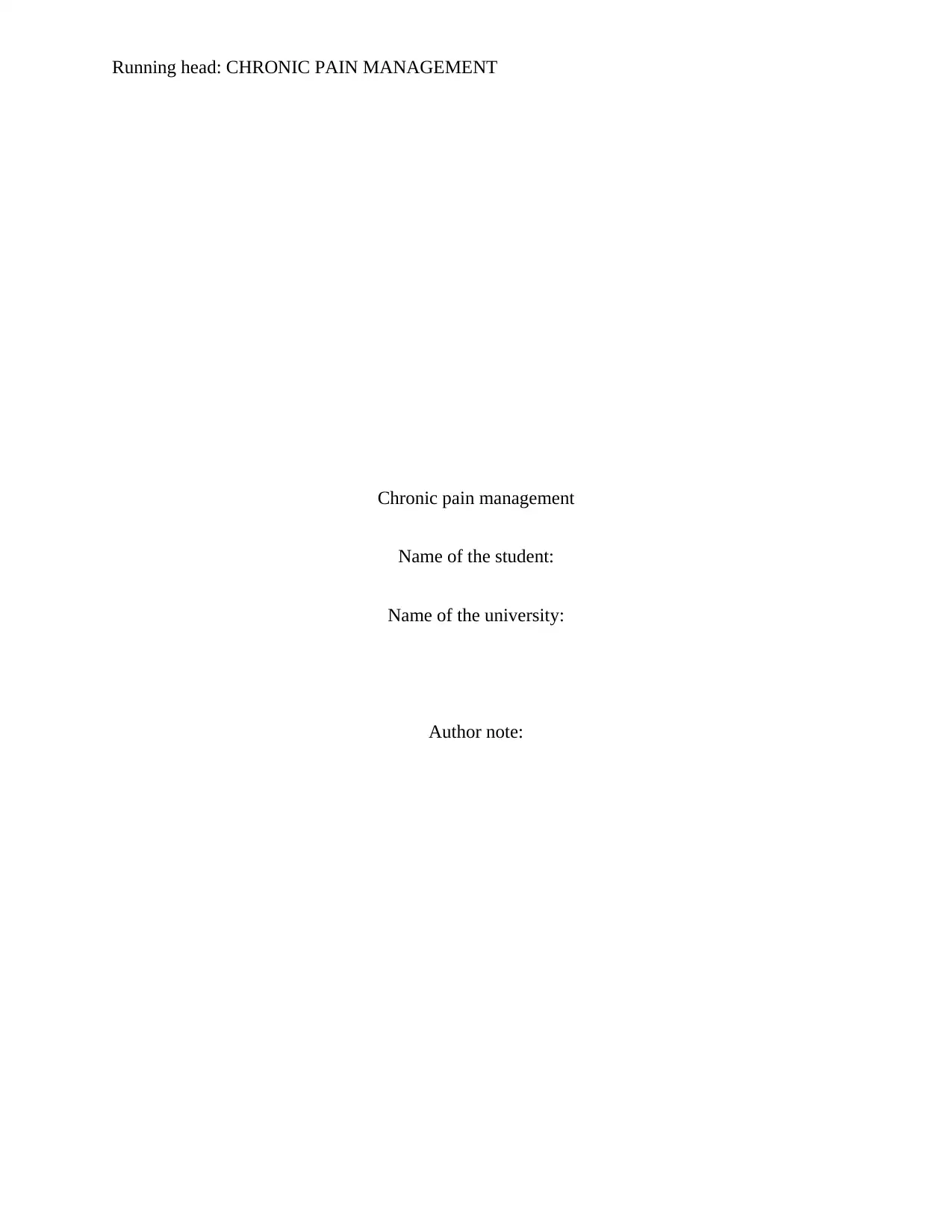
Running head: CHRONIC PAIN MANAGEMENT
Chronic pain management
Name of the student:
Name of the university:
Author note:
Chronic pain management
Name of the student:
Name of the university:
Author note:
Paraphrase This Document
Need a fresh take? Get an instant paraphrase of this document with our AI Paraphraser
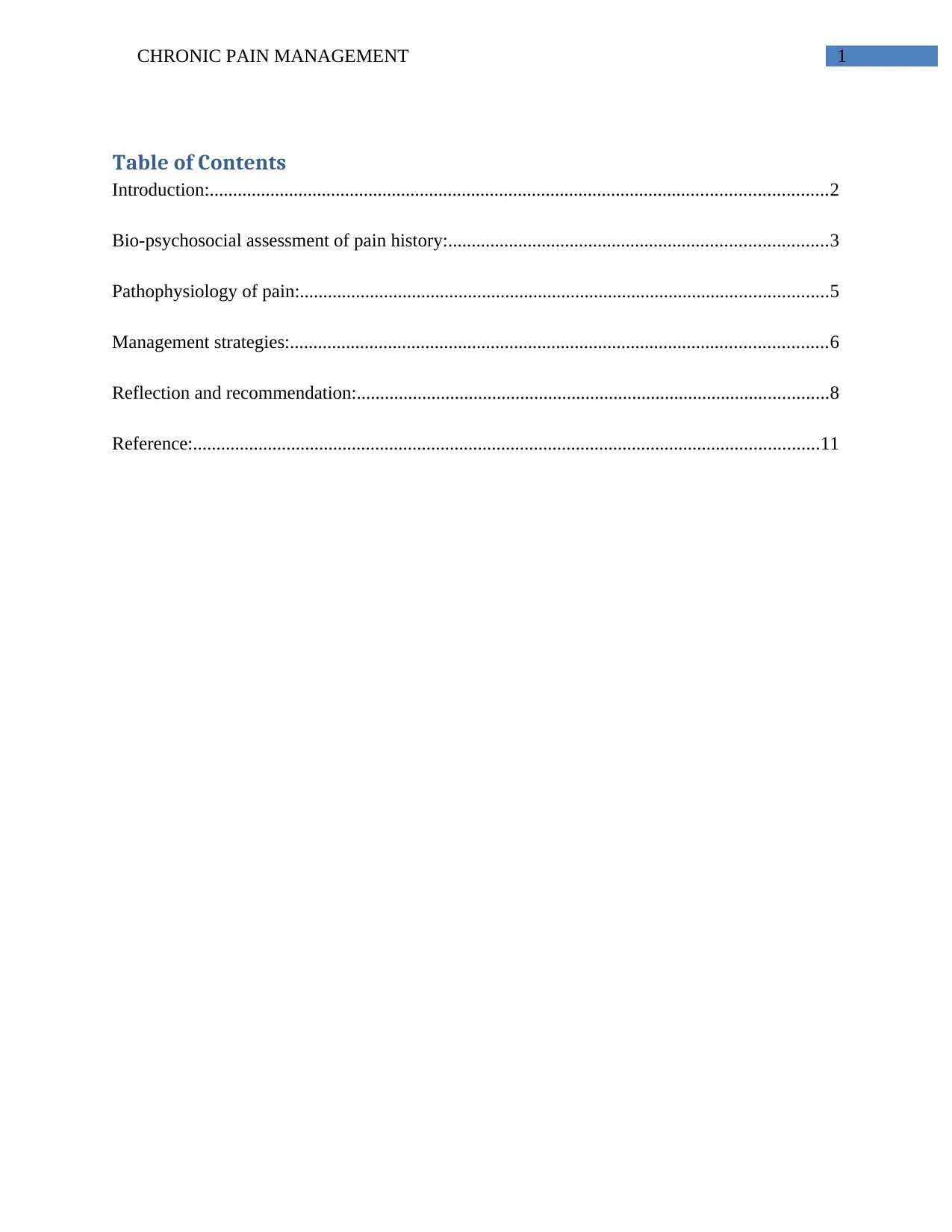
CHRONIC PAIN MANAGEMENT 1
Table of Contents
Introduction:....................................................................................................................................2
Bio-psychosocial assessment of pain history:.................................................................................3
Pathophysiology of pain:.................................................................................................................5
Management strategies:...................................................................................................................6
Reflection and recommendation:.....................................................................................................8
Reference:......................................................................................................................................11
Table of Contents
Introduction:....................................................................................................................................2
Bio-psychosocial assessment of pain history:.................................................................................3
Pathophysiology of pain:.................................................................................................................5
Management strategies:...................................................................................................................6
Reflection and recommendation:.....................................................................................................8
Reference:......................................................................................................................................11
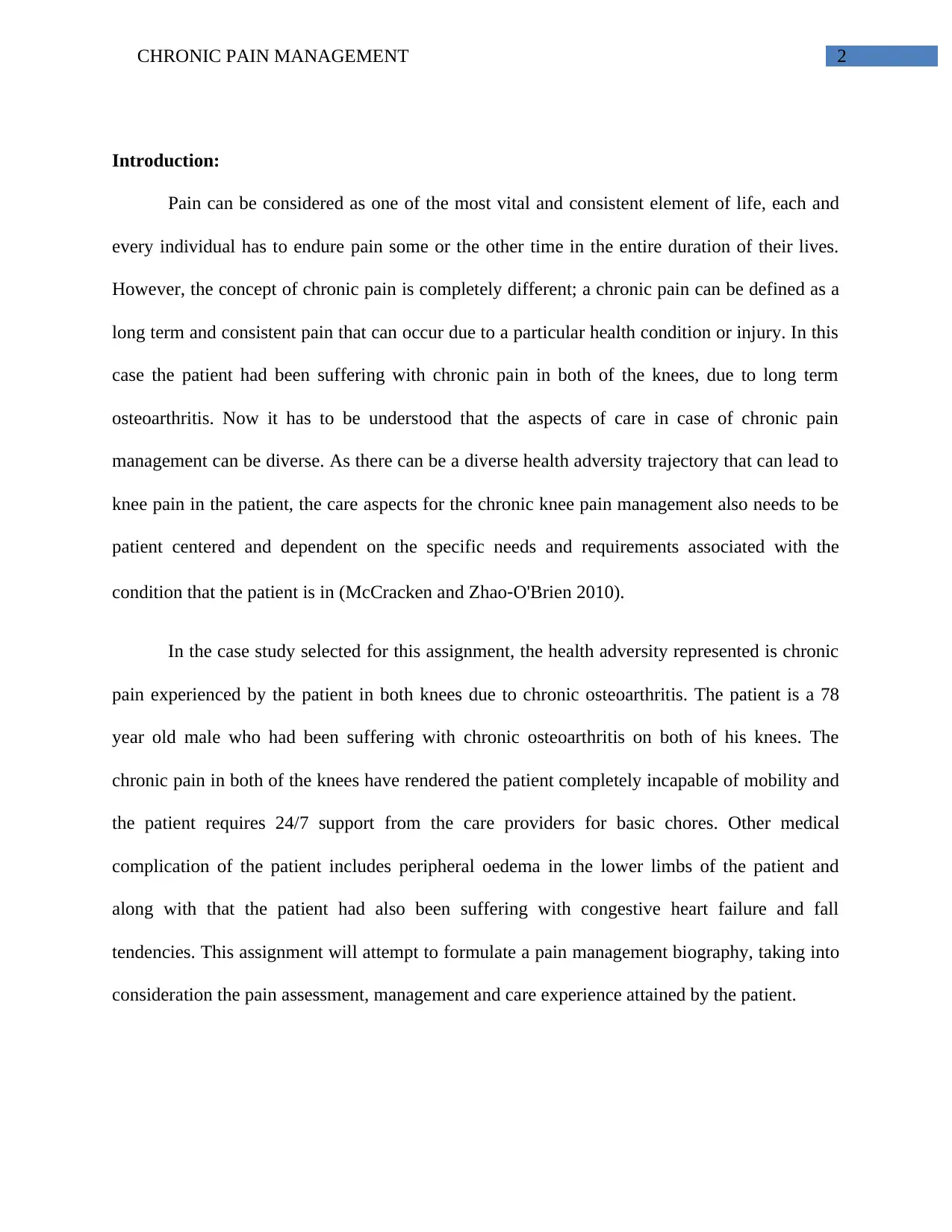
CHRONIC PAIN MANAGEMENT 2
Introduction:
Pain can be considered as one of the most vital and consistent element of life, each and
every individual has to endure pain some or the other time in the entire duration of their lives.
However, the concept of chronic pain is completely different; a chronic pain can be defined as a
long term and consistent pain that can occur due to a particular health condition or injury. In this
case the patient had been suffering with chronic pain in both of the knees, due to long term
osteoarthritis. Now it has to be understood that the aspects of care in case of chronic pain
management can be diverse. As there can be a diverse health adversity trajectory that can lead to
knee pain in the patient, the care aspects for the chronic knee pain management also needs to be
patient centered and dependent on the specific needs and requirements associated with the
condition that the patient is in (McCracken and Zhao‐O'Brien 2010).
In the case study selected for this assignment, the health adversity represented is chronic
pain experienced by the patient in both knees due to chronic osteoarthritis. The patient is a 78
year old male who had been suffering with chronic osteoarthritis on both of his knees. The
chronic pain in both of the knees have rendered the patient completely incapable of mobility and
the patient requires 24/7 support from the care providers for basic chores. Other medical
complication of the patient includes peripheral oedema in the lower limbs of the patient and
along with that the patient had also been suffering with congestive heart failure and fall
tendencies. This assignment will attempt to formulate a pain management biography, taking into
consideration the pain assessment, management and care experience attained by the patient.
Introduction:
Pain can be considered as one of the most vital and consistent element of life, each and
every individual has to endure pain some or the other time in the entire duration of their lives.
However, the concept of chronic pain is completely different; a chronic pain can be defined as a
long term and consistent pain that can occur due to a particular health condition or injury. In this
case the patient had been suffering with chronic pain in both of the knees, due to long term
osteoarthritis. Now it has to be understood that the aspects of care in case of chronic pain
management can be diverse. As there can be a diverse health adversity trajectory that can lead to
knee pain in the patient, the care aspects for the chronic knee pain management also needs to be
patient centered and dependent on the specific needs and requirements associated with the
condition that the patient is in (McCracken and Zhao‐O'Brien 2010).
In the case study selected for this assignment, the health adversity represented is chronic
pain experienced by the patient in both knees due to chronic osteoarthritis. The patient is a 78
year old male who had been suffering with chronic osteoarthritis on both of his knees. The
chronic pain in both of the knees have rendered the patient completely incapable of mobility and
the patient requires 24/7 support from the care providers for basic chores. Other medical
complication of the patient includes peripheral oedema in the lower limbs of the patient and
along with that the patient had also been suffering with congestive heart failure and fall
tendencies. This assignment will attempt to formulate a pain management biography, taking into
consideration the pain assessment, management and care experience attained by the patient.
⊘ This is a preview!⊘
Do you want full access?
Subscribe today to unlock all pages.

Trusted by 1+ million students worldwide
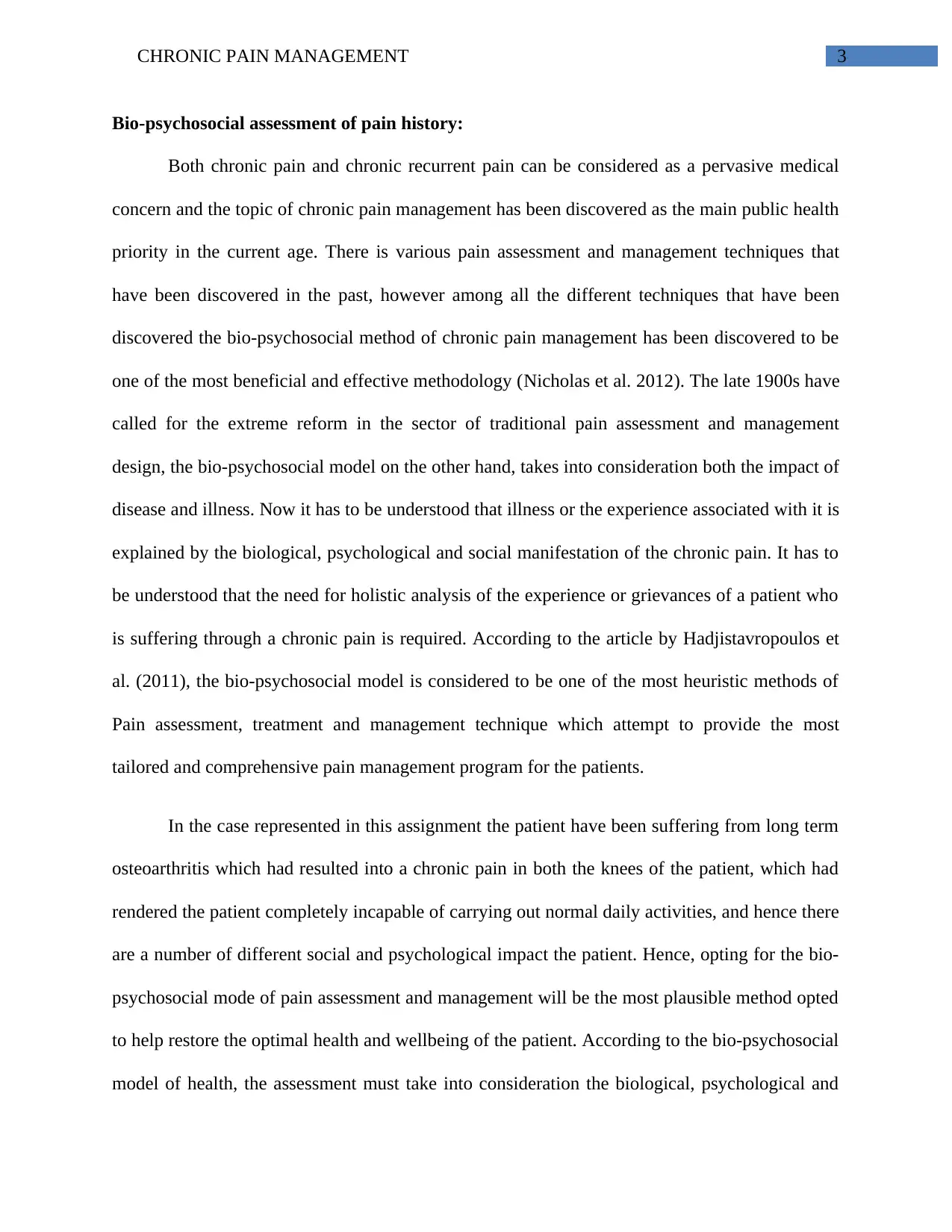
CHRONIC PAIN MANAGEMENT 3
Bio-psychosocial assessment of pain history:
Both chronic pain and chronic recurrent pain can be considered as a pervasive medical
concern and the topic of chronic pain management has been discovered as the main public health
priority in the current age. There is various pain assessment and management techniques that
have been discovered in the past, however among all the different techniques that have been
discovered the bio-psychosocial method of chronic pain management has been discovered to be
one of the most beneficial and effective methodology (Nicholas et al. 2012). The late 1900s have
called for the extreme reform in the sector of traditional pain assessment and management
design, the bio-psychosocial model on the other hand, takes into consideration both the impact of
disease and illness. Now it has to be understood that illness or the experience associated with it is
explained by the biological, psychological and social manifestation of the chronic pain. It has to
be understood that the need for holistic analysis of the experience or grievances of a patient who
is suffering through a chronic pain is required. According to the article by Hadjistavropoulos et
al. (2011), the bio-psychosocial model is considered to be one of the most heuristic methods of
Pain assessment, treatment and management technique which attempt to provide the most
tailored and comprehensive pain management program for the patients.
In the case represented in this assignment the patient have been suffering from long term
osteoarthritis which had resulted into a chronic pain in both the knees of the patient, which had
rendered the patient completely incapable of carrying out normal daily activities, and hence there
are a number of different social and psychological impact the patient. Hence, opting for the bio-
psychosocial mode of pain assessment and management will be the most plausible method opted
to help restore the optimal health and wellbeing of the patient. According to the bio-psychosocial
model of health, the assessment must take into consideration the biological, psychological and
Bio-psychosocial assessment of pain history:
Both chronic pain and chronic recurrent pain can be considered as a pervasive medical
concern and the topic of chronic pain management has been discovered as the main public health
priority in the current age. There is various pain assessment and management techniques that
have been discovered in the past, however among all the different techniques that have been
discovered the bio-psychosocial method of chronic pain management has been discovered to be
one of the most beneficial and effective methodology (Nicholas et al. 2012). The late 1900s have
called for the extreme reform in the sector of traditional pain assessment and management
design, the bio-psychosocial model on the other hand, takes into consideration both the impact of
disease and illness. Now it has to be understood that illness or the experience associated with it is
explained by the biological, psychological and social manifestation of the chronic pain. It has to
be understood that the need for holistic analysis of the experience or grievances of a patient who
is suffering through a chronic pain is required. According to the article by Hadjistavropoulos et
al. (2011), the bio-psychosocial model is considered to be one of the most heuristic methods of
Pain assessment, treatment and management technique which attempt to provide the most
tailored and comprehensive pain management program for the patients.
In the case represented in this assignment the patient have been suffering from long term
osteoarthritis which had resulted into a chronic pain in both the knees of the patient, which had
rendered the patient completely incapable of carrying out normal daily activities, and hence there
are a number of different social and psychological impact the patient. Hence, opting for the bio-
psychosocial mode of pain assessment and management will be the most plausible method opted
to help restore the optimal health and wellbeing of the patient. According to the bio-psychosocial
model of health, the assessment must take into consideration the biological, psychological and
Paraphrase This Document
Need a fresh take? Get an instant paraphrase of this document with our AI Paraphraser
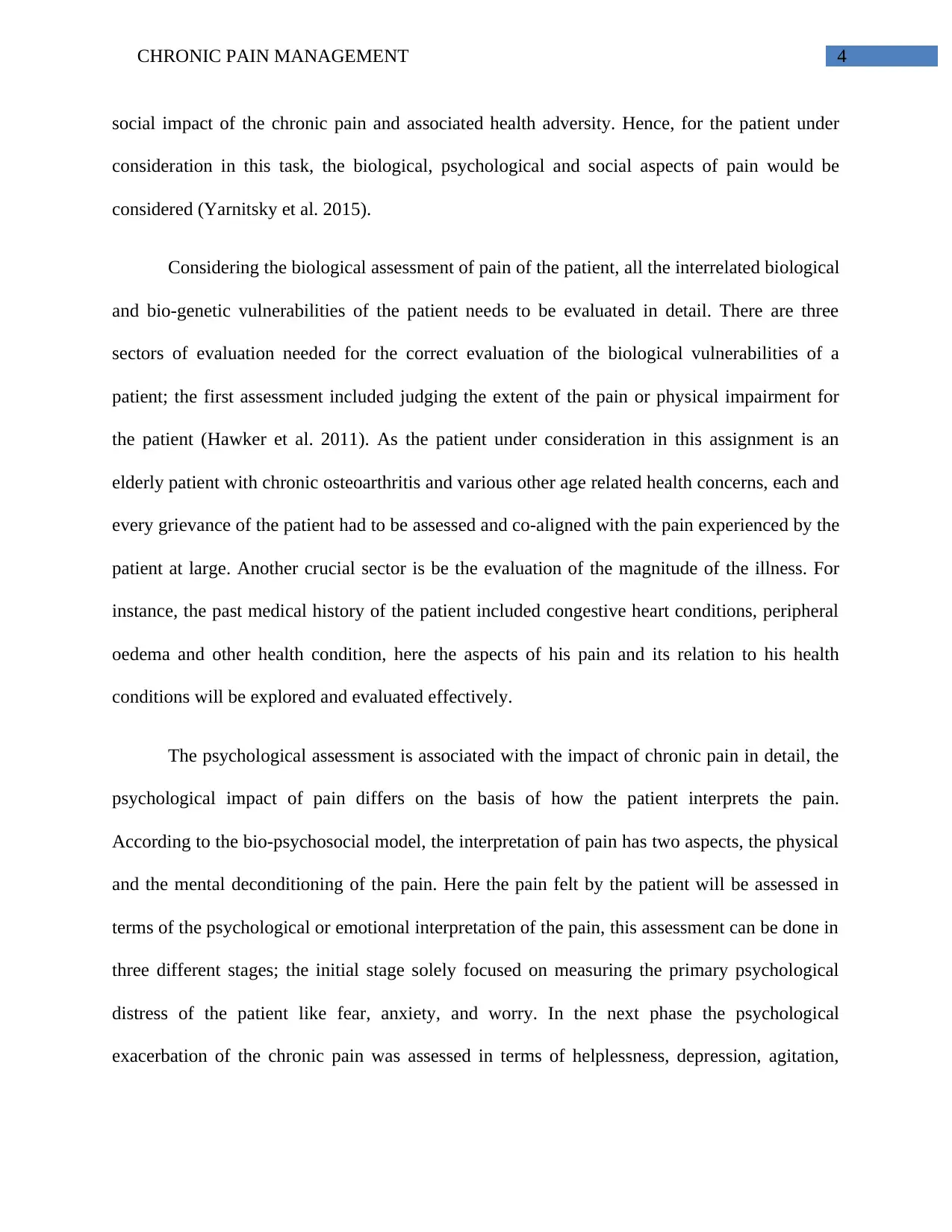
CHRONIC PAIN MANAGEMENT 4
social impact of the chronic pain and associated health adversity. Hence, for the patient under
consideration in this task, the biological, psychological and social aspects of pain would be
considered (Yarnitsky et al. 2015).
Considering the biological assessment of pain of the patient, all the interrelated biological
and bio-genetic vulnerabilities of the patient needs to be evaluated in detail. There are three
sectors of evaluation needed for the correct evaluation of the biological vulnerabilities of a
patient; the first assessment included judging the extent of the pain or physical impairment for
the patient (Hawker et al. 2011). As the patient under consideration in this assignment is an
elderly patient with chronic osteoarthritis and various other age related health concerns, each and
every grievance of the patient had to be assessed and co-aligned with the pain experienced by the
patient at large. Another crucial sector is be the evaluation of the magnitude of the illness. For
instance, the past medical history of the patient included congestive heart conditions, peripheral
oedema and other health condition, here the aspects of his pain and its relation to his health
conditions will be explored and evaluated effectively.
The psychological assessment is associated with the impact of chronic pain in detail, the
psychological impact of pain differs on the basis of how the patient interprets the pain.
According to the bio-psychosocial model, the interpretation of pain has two aspects, the physical
and the mental deconditioning of the pain. Here the pain felt by the patient will be assessed in
terms of the psychological or emotional interpretation of the pain, this assessment can be done in
three different stages; the initial stage solely focused on measuring the primary psychological
distress of the patient like fear, anxiety, and worry. In the next phase the psychological
exacerbation of the chronic pain was assessed in terms of helplessness, depression, agitation,
social impact of the chronic pain and associated health adversity. Hence, for the patient under
consideration in this task, the biological, psychological and social aspects of pain would be
considered (Yarnitsky et al. 2015).
Considering the biological assessment of pain of the patient, all the interrelated biological
and bio-genetic vulnerabilities of the patient needs to be evaluated in detail. There are three
sectors of evaluation needed for the correct evaluation of the biological vulnerabilities of a
patient; the first assessment included judging the extent of the pain or physical impairment for
the patient (Hawker et al. 2011). As the patient under consideration in this assignment is an
elderly patient with chronic osteoarthritis and various other age related health concerns, each and
every grievance of the patient had to be assessed and co-aligned with the pain experienced by the
patient at large. Another crucial sector is be the evaluation of the magnitude of the illness. For
instance, the past medical history of the patient included congestive heart conditions, peripheral
oedema and other health condition, here the aspects of his pain and its relation to his health
conditions will be explored and evaluated effectively.
The psychological assessment is associated with the impact of chronic pain in detail, the
psychological impact of pain differs on the basis of how the patient interprets the pain.
According to the bio-psychosocial model, the interpretation of pain has two aspects, the physical
and the mental deconditioning of the pain. Here the pain felt by the patient will be assessed in
terms of the psychological or emotional interpretation of the pain, this assessment can be done in
three different stages; the initial stage solely focused on measuring the primary psychological
distress of the patient like fear, anxiety, and worry. In the next phase the psychological
exacerbation of the chronic pain was assessed in terms of helplessness, depression, agitation,
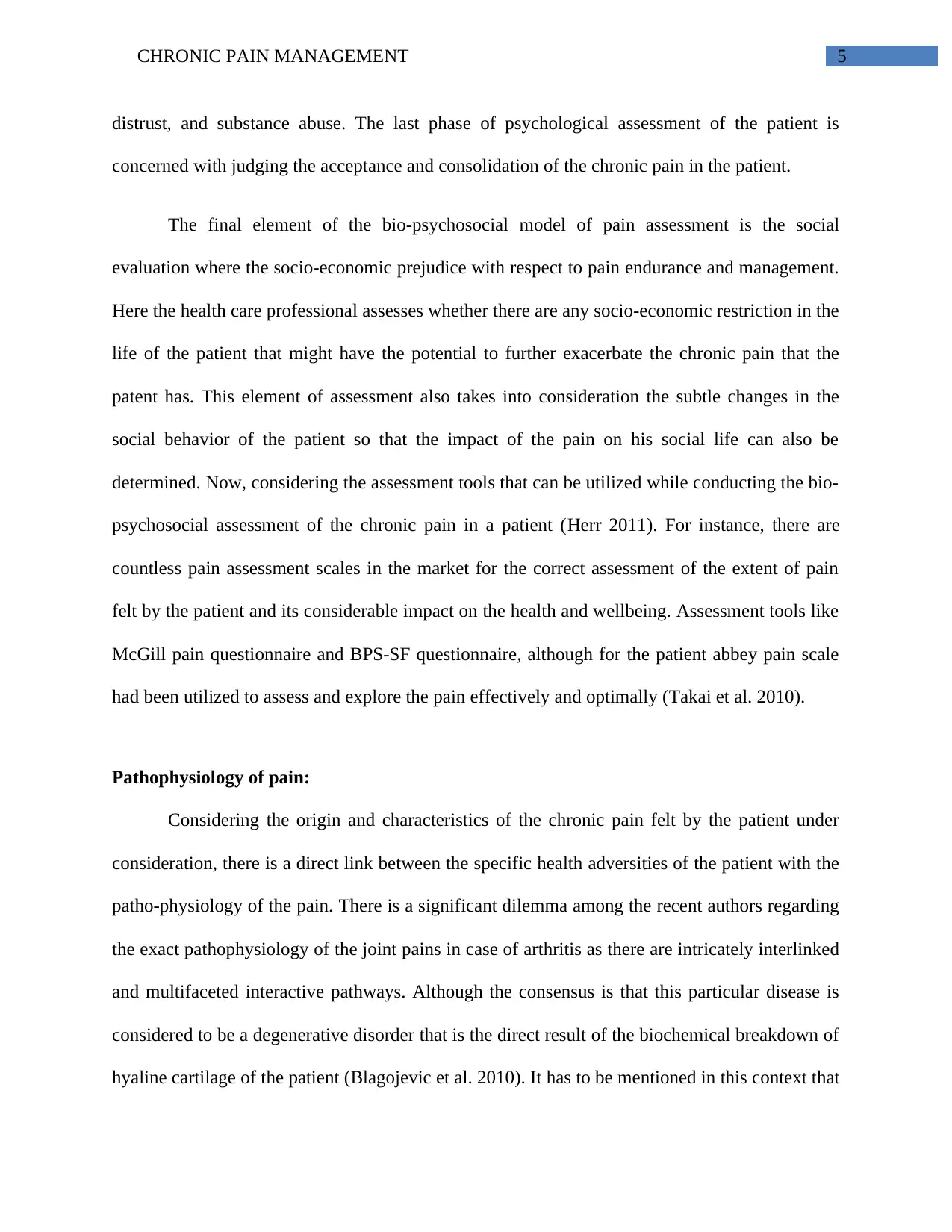
CHRONIC PAIN MANAGEMENT 5
distrust, and substance abuse. The last phase of psychological assessment of the patient is
concerned with judging the acceptance and consolidation of the chronic pain in the patient.
The final element of the bio-psychosocial model of pain assessment is the social
evaluation where the socio-economic prejudice with respect to pain endurance and management.
Here the health care professional assesses whether there are any socio-economic restriction in the
life of the patient that might have the potential to further exacerbate the chronic pain that the
patent has. This element of assessment also takes into consideration the subtle changes in the
social behavior of the patient so that the impact of the pain on his social life can also be
determined. Now, considering the assessment tools that can be utilized while conducting the bio-
psychosocial assessment of the chronic pain in a patient (Herr 2011). For instance, there are
countless pain assessment scales in the market for the correct assessment of the extent of pain
felt by the patient and its considerable impact on the health and wellbeing. Assessment tools like
McGill pain questionnaire and BPS-SF questionnaire, although for the patient abbey pain scale
had been utilized to assess and explore the pain effectively and optimally (Takai et al. 2010).
Pathophysiology of pain:
Considering the origin and characteristics of the chronic pain felt by the patient under
consideration, there is a direct link between the specific health adversities of the patient with the
patho-physiology of the pain. There is a significant dilemma among the recent authors regarding
the exact pathophysiology of the joint pains in case of arthritis as there are intricately interlinked
and multifaceted interactive pathways. Although the consensus is that this particular disease is
considered to be a degenerative disorder that is the direct result of the biochemical breakdown of
hyaline cartilage of the patient (Blagojevic et al. 2010). It has to be mentioned in this context that
distrust, and substance abuse. The last phase of psychological assessment of the patient is
concerned with judging the acceptance and consolidation of the chronic pain in the patient.
The final element of the bio-psychosocial model of pain assessment is the social
evaluation where the socio-economic prejudice with respect to pain endurance and management.
Here the health care professional assesses whether there are any socio-economic restriction in the
life of the patient that might have the potential to further exacerbate the chronic pain that the
patent has. This element of assessment also takes into consideration the subtle changes in the
social behavior of the patient so that the impact of the pain on his social life can also be
determined. Now, considering the assessment tools that can be utilized while conducting the bio-
psychosocial assessment of the chronic pain in a patient (Herr 2011). For instance, there are
countless pain assessment scales in the market for the correct assessment of the extent of pain
felt by the patient and its considerable impact on the health and wellbeing. Assessment tools like
McGill pain questionnaire and BPS-SF questionnaire, although for the patient abbey pain scale
had been utilized to assess and explore the pain effectively and optimally (Takai et al. 2010).
Pathophysiology of pain:
Considering the origin and characteristics of the chronic pain felt by the patient under
consideration, there is a direct link between the specific health adversities of the patient with the
patho-physiology of the pain. There is a significant dilemma among the recent authors regarding
the exact pathophysiology of the joint pains in case of arthritis as there are intricately interlinked
and multifaceted interactive pathways. Although the consensus is that this particular disease is
considered to be a degenerative disorder that is the direct result of the biochemical breakdown of
hyaline cartilage of the patient (Blagojevic et al. 2010). It has to be mentioned in this context that
⊘ This is a preview!⊘
Do you want full access?
Subscribe today to unlock all pages.

Trusted by 1+ million students worldwide
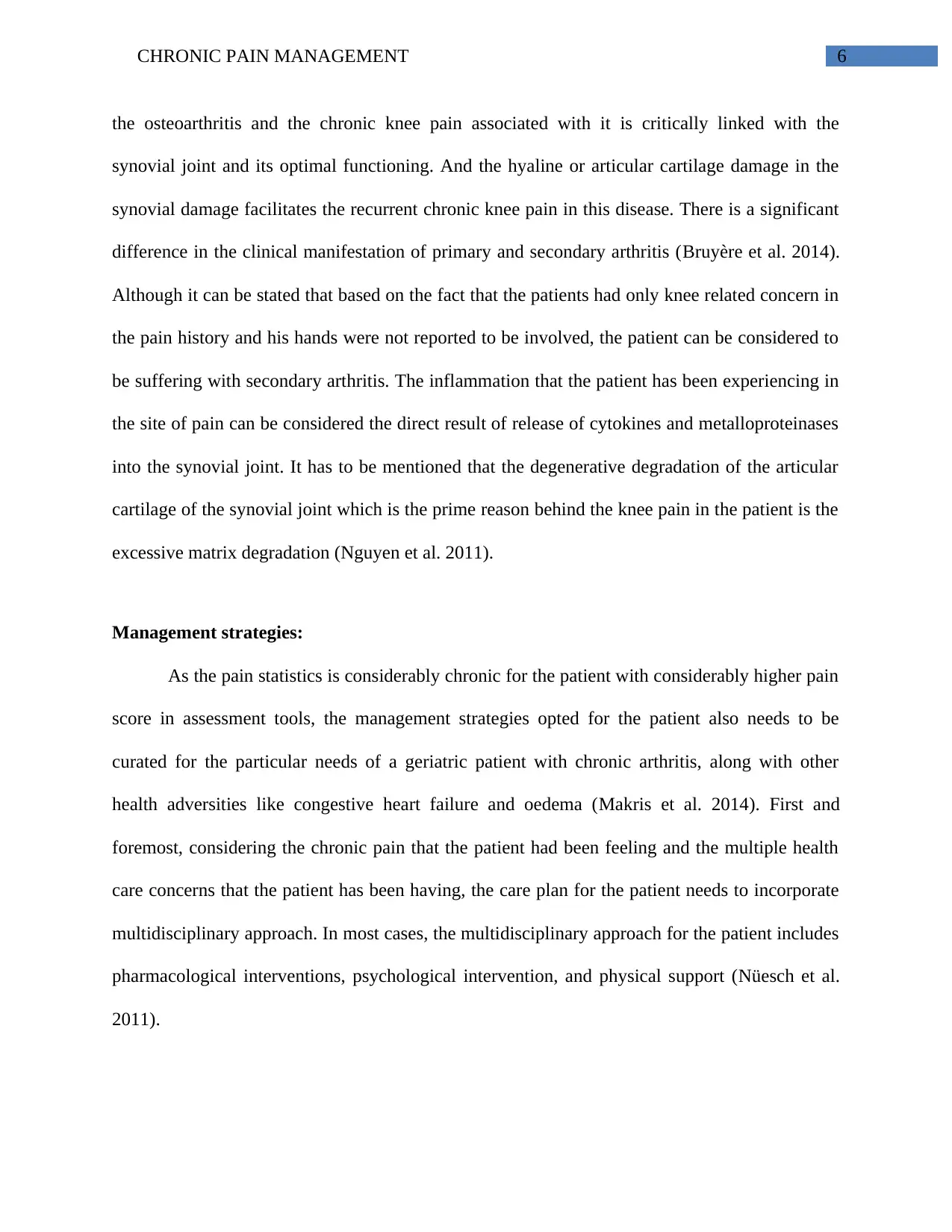
CHRONIC PAIN MANAGEMENT 6
the osteoarthritis and the chronic knee pain associated with it is critically linked with the
synovial joint and its optimal functioning. And the hyaline or articular cartilage damage in the
synovial damage facilitates the recurrent chronic knee pain in this disease. There is a significant
difference in the clinical manifestation of primary and secondary arthritis (Bruyère et al. 2014).
Although it can be stated that based on the fact that the patients had only knee related concern in
the pain history and his hands were not reported to be involved, the patient can be considered to
be suffering with secondary arthritis. The inflammation that the patient has been experiencing in
the site of pain can be considered the direct result of release of cytokines and metalloproteinases
into the synovial joint. It has to be mentioned that the degenerative degradation of the articular
cartilage of the synovial joint which is the prime reason behind the knee pain in the patient is the
excessive matrix degradation (Nguyen et al. 2011).
Management strategies:
As the pain statistics is considerably chronic for the patient with considerably higher pain
score in assessment tools, the management strategies opted for the patient also needs to be
curated for the particular needs of a geriatric patient with chronic arthritis, along with other
health adversities like congestive heart failure and oedema (Makris et al. 2014). First and
foremost, considering the chronic pain that the patient had been feeling and the multiple health
care concerns that the patient has been having, the care plan for the patient needs to incorporate
multidisciplinary approach. In most cases, the multidisciplinary approach for the patient includes
pharmacological interventions, psychological intervention, and physical support (Nüesch et al.
2011).
the osteoarthritis and the chronic knee pain associated with it is critically linked with the
synovial joint and its optimal functioning. And the hyaline or articular cartilage damage in the
synovial damage facilitates the recurrent chronic knee pain in this disease. There is a significant
difference in the clinical manifestation of primary and secondary arthritis (Bruyère et al. 2014).
Although it can be stated that based on the fact that the patients had only knee related concern in
the pain history and his hands were not reported to be involved, the patient can be considered to
be suffering with secondary arthritis. The inflammation that the patient has been experiencing in
the site of pain can be considered the direct result of release of cytokines and metalloproteinases
into the synovial joint. It has to be mentioned that the degenerative degradation of the articular
cartilage of the synovial joint which is the prime reason behind the knee pain in the patient is the
excessive matrix degradation (Nguyen et al. 2011).
Management strategies:
As the pain statistics is considerably chronic for the patient with considerably higher pain
score in assessment tools, the management strategies opted for the patient also needs to be
curated for the particular needs of a geriatric patient with chronic arthritis, along with other
health adversities like congestive heart failure and oedema (Makris et al. 2014). First and
foremost, considering the chronic pain that the patient had been feeling and the multiple health
care concerns that the patient has been having, the care plan for the patient needs to incorporate
multidisciplinary approach. In most cases, the multidisciplinary approach for the patient includes
pharmacological interventions, psychological intervention, and physical support (Nüesch et al.
2011).
Paraphrase This Document
Need a fresh take? Get an instant paraphrase of this document with our AI Paraphraser
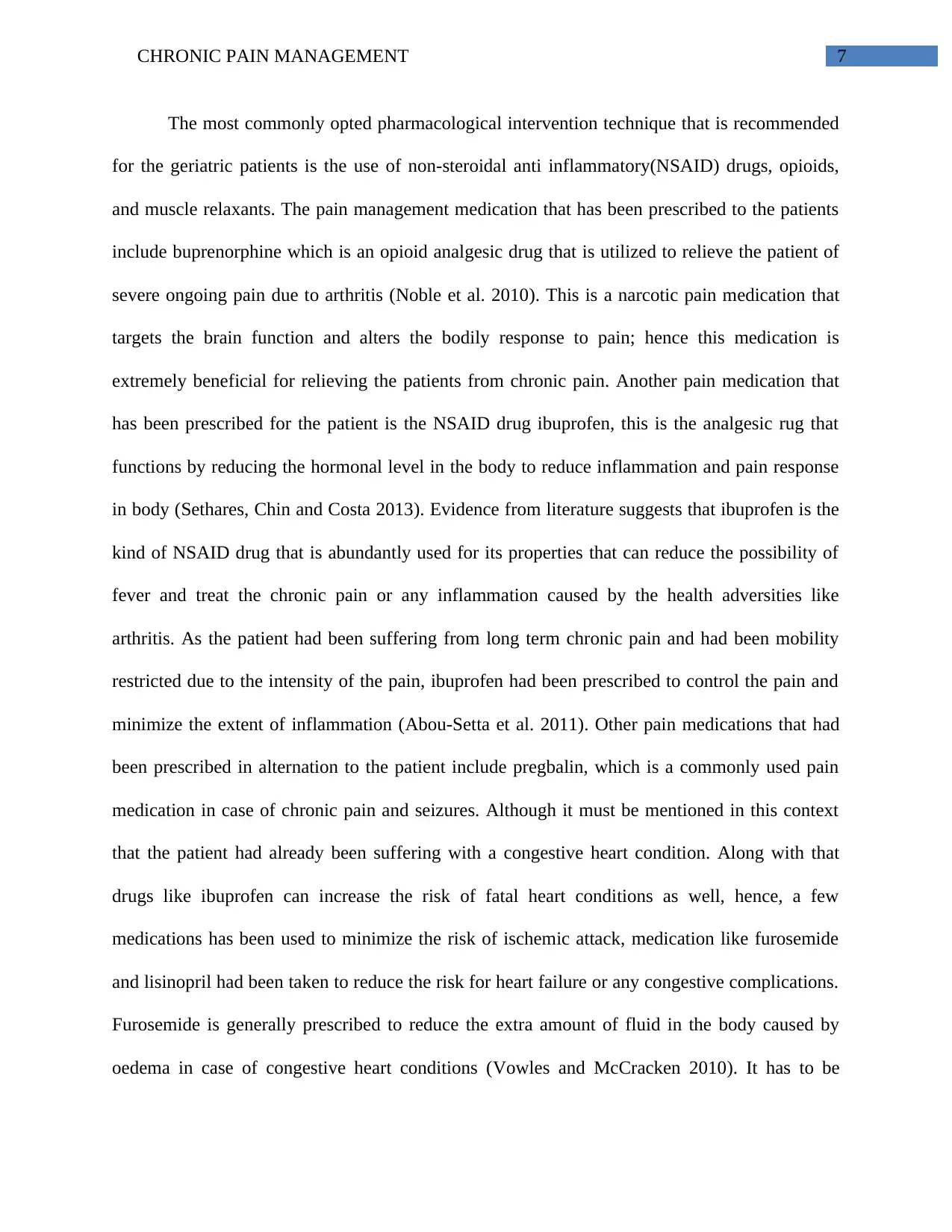
CHRONIC PAIN MANAGEMENT 7
The most commonly opted pharmacological intervention technique that is recommended
for the geriatric patients is the use of non-steroidal anti inflammatory(NSAID) drugs, opioids,
and muscle relaxants. The pain management medication that has been prescribed to the patients
include buprenorphine which is an opioid analgesic drug that is utilized to relieve the patient of
severe ongoing pain due to arthritis (Noble et al. 2010). This is a narcotic pain medication that
targets the brain function and alters the bodily response to pain; hence this medication is
extremely beneficial for relieving the patients from chronic pain. Another pain medication that
has been prescribed for the patient is the NSAID drug ibuprofen, this is the analgesic rug that
functions by reducing the hormonal level in the body to reduce inflammation and pain response
in body (Sethares, Chin and Costa 2013). Evidence from literature suggests that ibuprofen is the
kind of NSAID drug that is abundantly used for its properties that can reduce the possibility of
fever and treat the chronic pain or any inflammation caused by the health adversities like
arthritis. As the patient had been suffering from long term chronic pain and had been mobility
restricted due to the intensity of the pain, ibuprofen had been prescribed to control the pain and
minimize the extent of inflammation (Abou-Setta et al. 2011). Other pain medications that had
been prescribed in alternation to the patient include pregbalin, which is a commonly used pain
medication in case of chronic pain and seizures. Although it must be mentioned in this context
that the patient had already been suffering with a congestive heart condition. Along with that
drugs like ibuprofen can increase the risk of fatal heart conditions as well, hence, a few
medications has been used to minimize the risk of ischemic attack, medication like furosemide
and lisinopril had been taken to reduce the risk for heart failure or any congestive complications.
Furosemide is generally prescribed to reduce the extra amount of fluid in the body caused by
oedema in case of congestive heart conditions (Vowles and McCracken 2010). It has to be
The most commonly opted pharmacological intervention technique that is recommended
for the geriatric patients is the use of non-steroidal anti inflammatory(NSAID) drugs, opioids,
and muscle relaxants. The pain management medication that has been prescribed to the patients
include buprenorphine which is an opioid analgesic drug that is utilized to relieve the patient of
severe ongoing pain due to arthritis (Noble et al. 2010). This is a narcotic pain medication that
targets the brain function and alters the bodily response to pain; hence this medication is
extremely beneficial for relieving the patients from chronic pain. Another pain medication that
has been prescribed for the patient is the NSAID drug ibuprofen, this is the analgesic rug that
functions by reducing the hormonal level in the body to reduce inflammation and pain response
in body (Sethares, Chin and Costa 2013). Evidence from literature suggests that ibuprofen is the
kind of NSAID drug that is abundantly used for its properties that can reduce the possibility of
fever and treat the chronic pain or any inflammation caused by the health adversities like
arthritis. As the patient had been suffering from long term chronic pain and had been mobility
restricted due to the intensity of the pain, ibuprofen had been prescribed to control the pain and
minimize the extent of inflammation (Abou-Setta et al. 2011). Other pain medications that had
been prescribed in alternation to the patient include pregbalin, which is a commonly used pain
medication in case of chronic pain and seizures. Although it must be mentioned in this context
that the patient had already been suffering with a congestive heart condition. Along with that
drugs like ibuprofen can increase the risk of fatal heart conditions as well, hence, a few
medications has been used to minimize the risk of ischemic attack, medication like furosemide
and lisinopril had been taken to reduce the risk for heart failure or any congestive complications.
Furosemide is generally prescribed to reduce the extra amount of fluid in the body caused by
oedema in case of congestive heart conditions (Vowles and McCracken 2010). It has to be
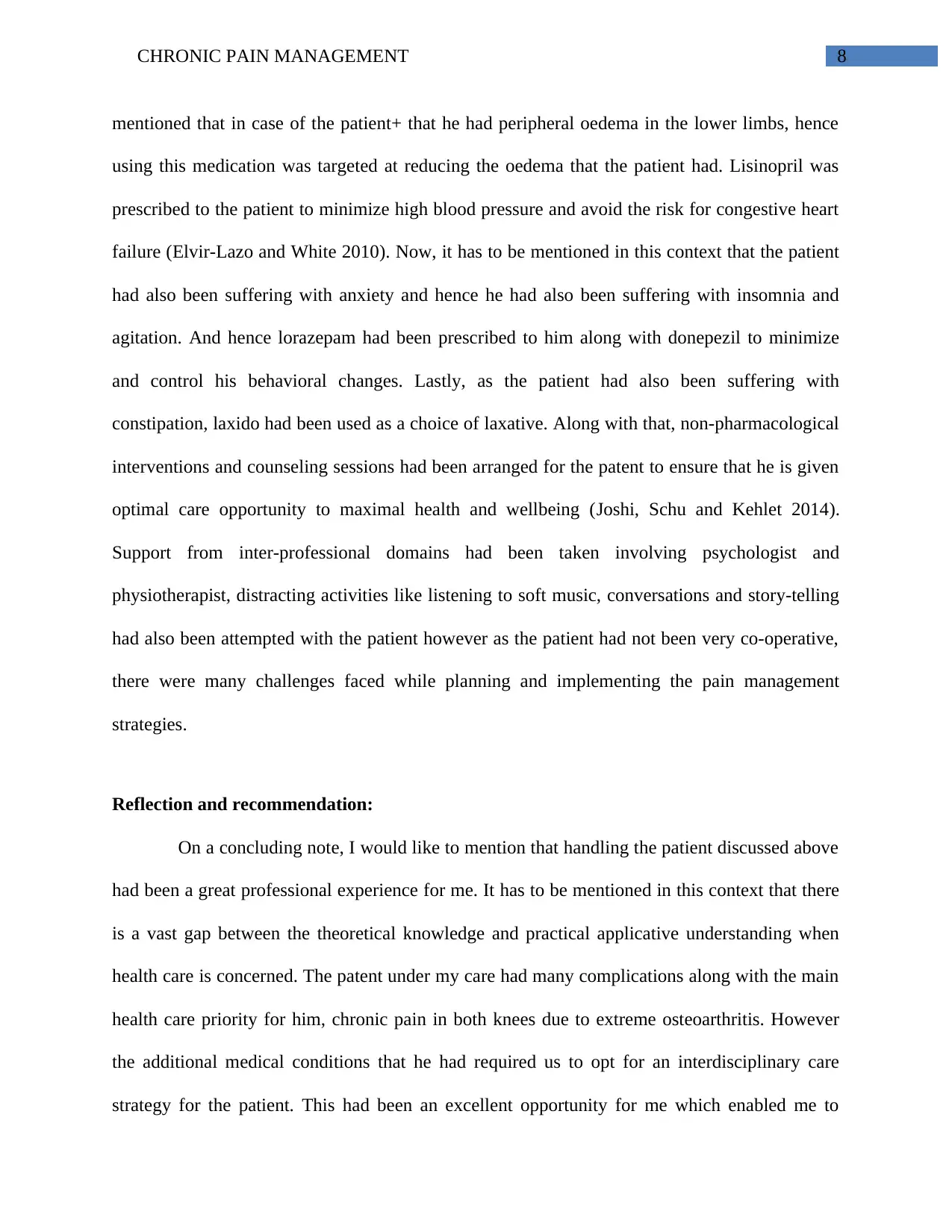
CHRONIC PAIN MANAGEMENT 8
mentioned that in case of the patient+ that he had peripheral oedema in the lower limbs, hence
using this medication was targeted at reducing the oedema that the patient had. Lisinopril was
prescribed to the patient to minimize high blood pressure and avoid the risk for congestive heart
failure (Elvir-Lazo and White 2010). Now, it has to be mentioned in this context that the patient
had also been suffering with anxiety and hence he had also been suffering with insomnia and
agitation. And hence lorazepam had been prescribed to him along with donepezil to minimize
and control his behavioral changes. Lastly, as the patient had also been suffering with
constipation, laxido had been used as a choice of laxative. Along with that, non-pharmacological
interventions and counseling sessions had been arranged for the patent to ensure that he is given
optimal care opportunity to maximal health and wellbeing (Joshi, Schu and Kehlet 2014).
Support from inter-professional domains had been taken involving psychologist and
physiotherapist, distracting activities like listening to soft music, conversations and story-telling
had also been attempted with the patient however as the patient had not been very co-operative,
there were many challenges faced while planning and implementing the pain management
strategies.
Reflection and recommendation:
On a concluding note, I would like to mention that handling the patient discussed above
had been a great professional experience for me. It has to be mentioned in this context that there
is a vast gap between the theoretical knowledge and practical applicative understanding when
health care is concerned. The patent under my care had many complications along with the main
health care priority for him, chronic pain in both knees due to extreme osteoarthritis. However
the additional medical conditions that he had required us to opt for an interdisciplinary care
strategy for the patient. This had been an excellent opportunity for me which enabled me to
mentioned that in case of the patient+ that he had peripheral oedema in the lower limbs, hence
using this medication was targeted at reducing the oedema that the patient had. Lisinopril was
prescribed to the patient to minimize high blood pressure and avoid the risk for congestive heart
failure (Elvir-Lazo and White 2010). Now, it has to be mentioned in this context that the patient
had also been suffering with anxiety and hence he had also been suffering with insomnia and
agitation. And hence lorazepam had been prescribed to him along with donepezil to minimize
and control his behavioral changes. Lastly, as the patient had also been suffering with
constipation, laxido had been used as a choice of laxative. Along with that, non-pharmacological
interventions and counseling sessions had been arranged for the patent to ensure that he is given
optimal care opportunity to maximal health and wellbeing (Joshi, Schu and Kehlet 2014).
Support from inter-professional domains had been taken involving psychologist and
physiotherapist, distracting activities like listening to soft music, conversations and story-telling
had also been attempted with the patient however as the patient had not been very co-operative,
there were many challenges faced while planning and implementing the pain management
strategies.
Reflection and recommendation:
On a concluding note, I would like to mention that handling the patient discussed above
had been a great professional experience for me. It has to be mentioned in this context that there
is a vast gap between the theoretical knowledge and practical applicative understanding when
health care is concerned. The patent under my care had many complications along with the main
health care priority for him, chronic pain in both knees due to extreme osteoarthritis. However
the additional medical conditions that he had required us to opt for an interdisciplinary care
strategy for the patient. This had been an excellent opportunity for me which enabled me to
⊘ This is a preview!⊘
Do you want full access?
Subscribe today to unlock all pages.

Trusted by 1+ million students worldwide
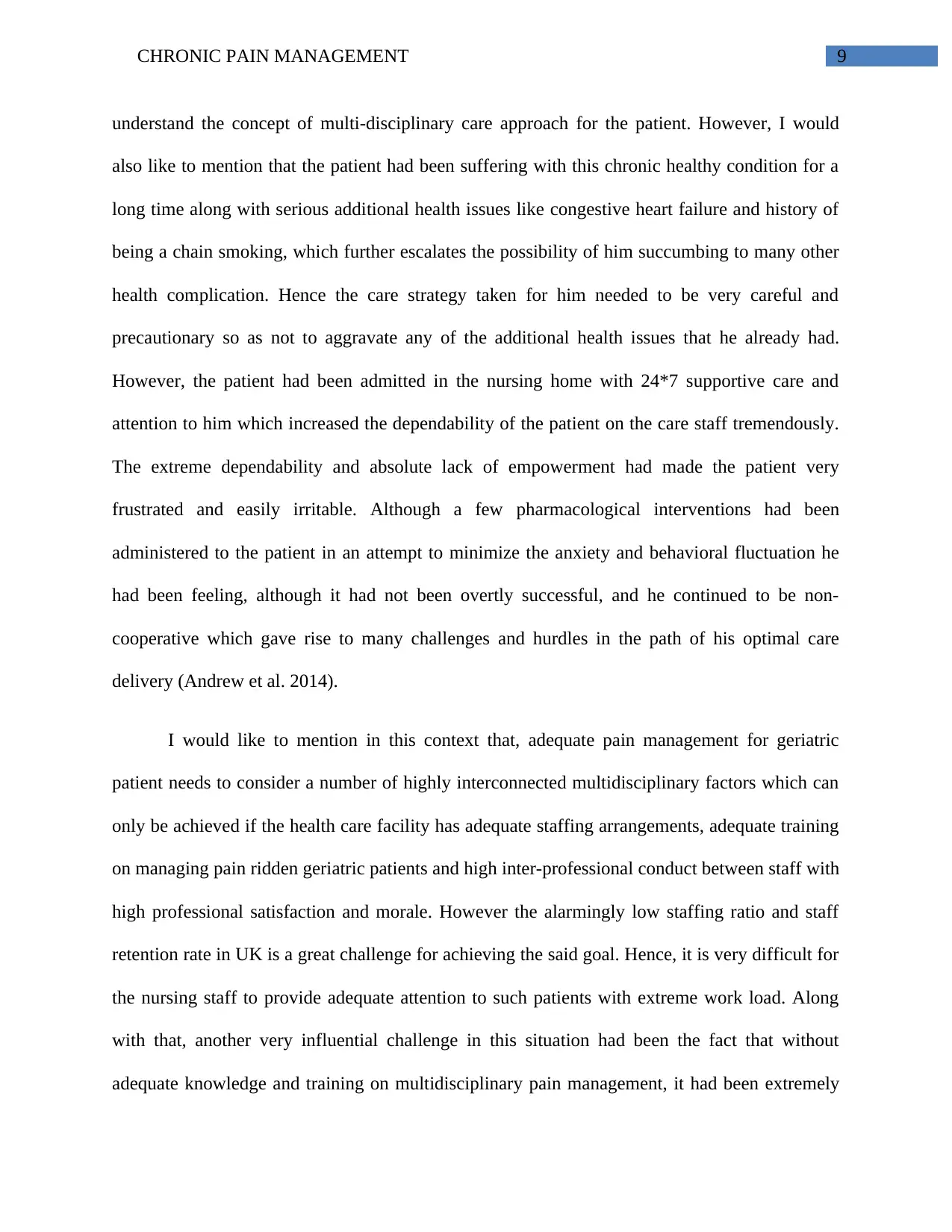
CHRONIC PAIN MANAGEMENT 9
understand the concept of multi-disciplinary care approach for the patient. However, I would
also like to mention that the patient had been suffering with this chronic healthy condition for a
long time along with serious additional health issues like congestive heart failure and history of
being a chain smoking, which further escalates the possibility of him succumbing to many other
health complication. Hence the care strategy taken for him needed to be very careful and
precautionary so as not to aggravate any of the additional health issues that he already had.
However, the patient had been admitted in the nursing home with 24*7 supportive care and
attention to him which increased the dependability of the patient on the care staff tremendously.
The extreme dependability and absolute lack of empowerment had made the patient very
frustrated and easily irritable. Although a few pharmacological interventions had been
administered to the patient in an attempt to minimize the anxiety and behavioral fluctuation he
had been feeling, although it had not been overtly successful, and he continued to be non-
cooperative which gave rise to many challenges and hurdles in the path of his optimal care
delivery (Andrew et al. 2014).
I would like to mention in this context that, adequate pain management for geriatric
patient needs to consider a number of highly interconnected multidisciplinary factors which can
only be achieved if the health care facility has adequate staffing arrangements, adequate training
on managing pain ridden geriatric patients and high inter-professional conduct between staff with
high professional satisfaction and morale. However the alarmingly low staffing ratio and staff
retention rate in UK is a great challenge for achieving the said goal. Hence, it is very difficult for
the nursing staff to provide adequate attention to such patients with extreme work load. Along
with that, another very influential challenge in this situation had been the fact that without
adequate knowledge and training on multidisciplinary pain management, it had been extremely
understand the concept of multi-disciplinary care approach for the patient. However, I would
also like to mention that the patient had been suffering with this chronic healthy condition for a
long time along with serious additional health issues like congestive heart failure and history of
being a chain smoking, which further escalates the possibility of him succumbing to many other
health complication. Hence the care strategy taken for him needed to be very careful and
precautionary so as not to aggravate any of the additional health issues that he already had.
However, the patient had been admitted in the nursing home with 24*7 supportive care and
attention to him which increased the dependability of the patient on the care staff tremendously.
The extreme dependability and absolute lack of empowerment had made the patient very
frustrated and easily irritable. Although a few pharmacological interventions had been
administered to the patient in an attempt to minimize the anxiety and behavioral fluctuation he
had been feeling, although it had not been overtly successful, and he continued to be non-
cooperative which gave rise to many challenges and hurdles in the path of his optimal care
delivery (Andrew et al. 2014).
I would like to mention in this context that, adequate pain management for geriatric
patient needs to consider a number of highly interconnected multidisciplinary factors which can
only be achieved if the health care facility has adequate staffing arrangements, adequate training
on managing pain ridden geriatric patients and high inter-professional conduct between staff with
high professional satisfaction and morale. However the alarmingly low staffing ratio and staff
retention rate in UK is a great challenge for achieving the said goal. Hence, it is very difficult for
the nursing staff to provide adequate attention to such patients with extreme work load. Along
with that, another very influential challenge in this situation had been the fact that without
adequate knowledge and training on multidisciplinary pain management, it had been extremely
Paraphrase This Document
Need a fresh take? Get an instant paraphrase of this document with our AI Paraphraser
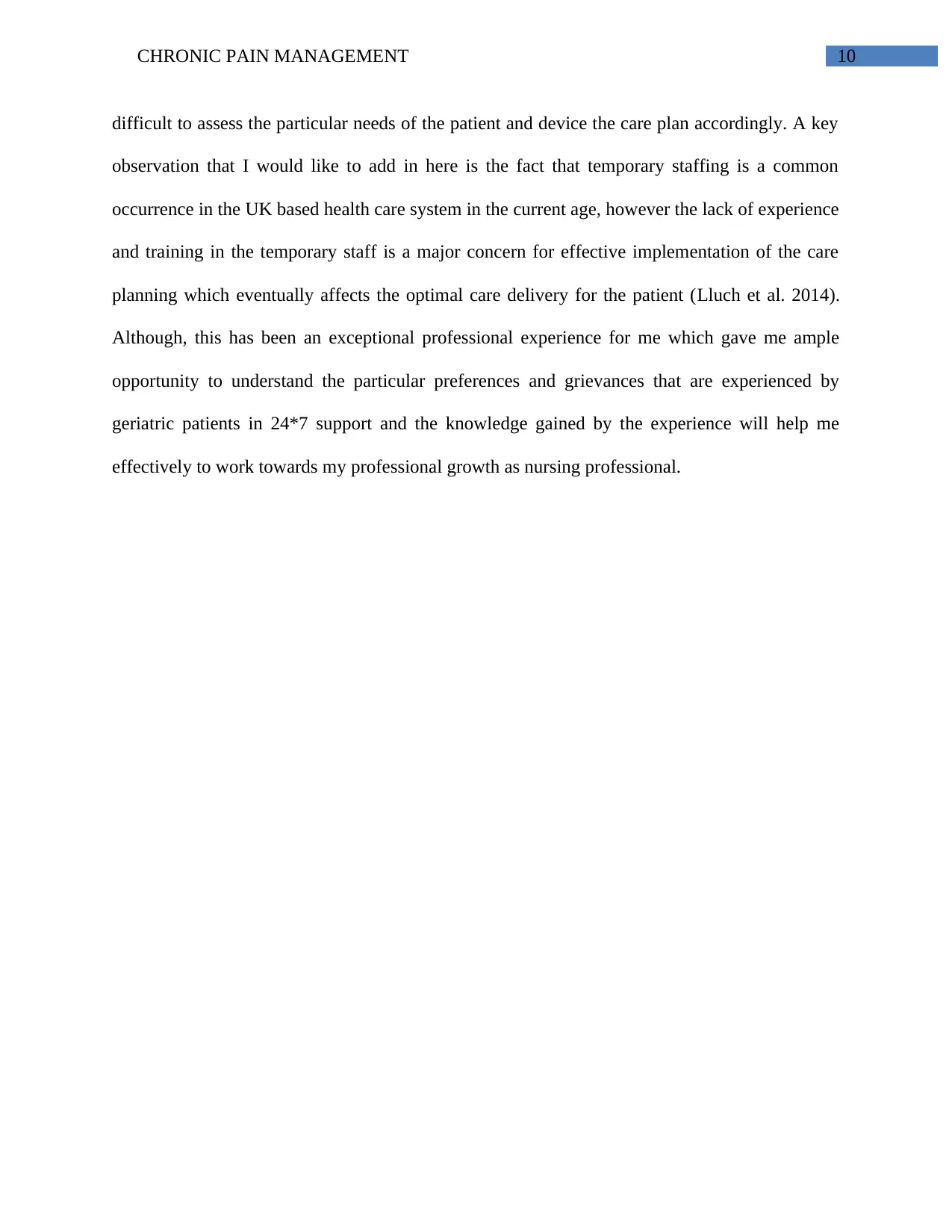
CHRONIC PAIN MANAGEMENT 10
difficult to assess the particular needs of the patient and device the care plan accordingly. A key
observation that I would like to add in here is the fact that temporary staffing is a common
occurrence in the UK based health care system in the current age, however the lack of experience
and training in the temporary staff is a major concern for effective implementation of the care
planning which eventually affects the optimal care delivery for the patient (Lluch et al. 2014).
Although, this has been an exceptional professional experience for me which gave me ample
opportunity to understand the particular preferences and grievances that are experienced by
geriatric patients in 24*7 support and the knowledge gained by the experience will help me
effectively to work towards my professional growth as nursing professional.
difficult to assess the particular needs of the patient and device the care plan accordingly. A key
observation that I would like to add in here is the fact that temporary staffing is a common
occurrence in the UK based health care system in the current age, however the lack of experience
and training in the temporary staff is a major concern for effective implementation of the care
planning which eventually affects the optimal care delivery for the patient (Lluch et al. 2014).
Although, this has been an exceptional professional experience for me which gave me ample
opportunity to understand the particular preferences and grievances that are experienced by
geriatric patients in 24*7 support and the knowledge gained by the experience will help me
effectively to work towards my professional growth as nursing professional.
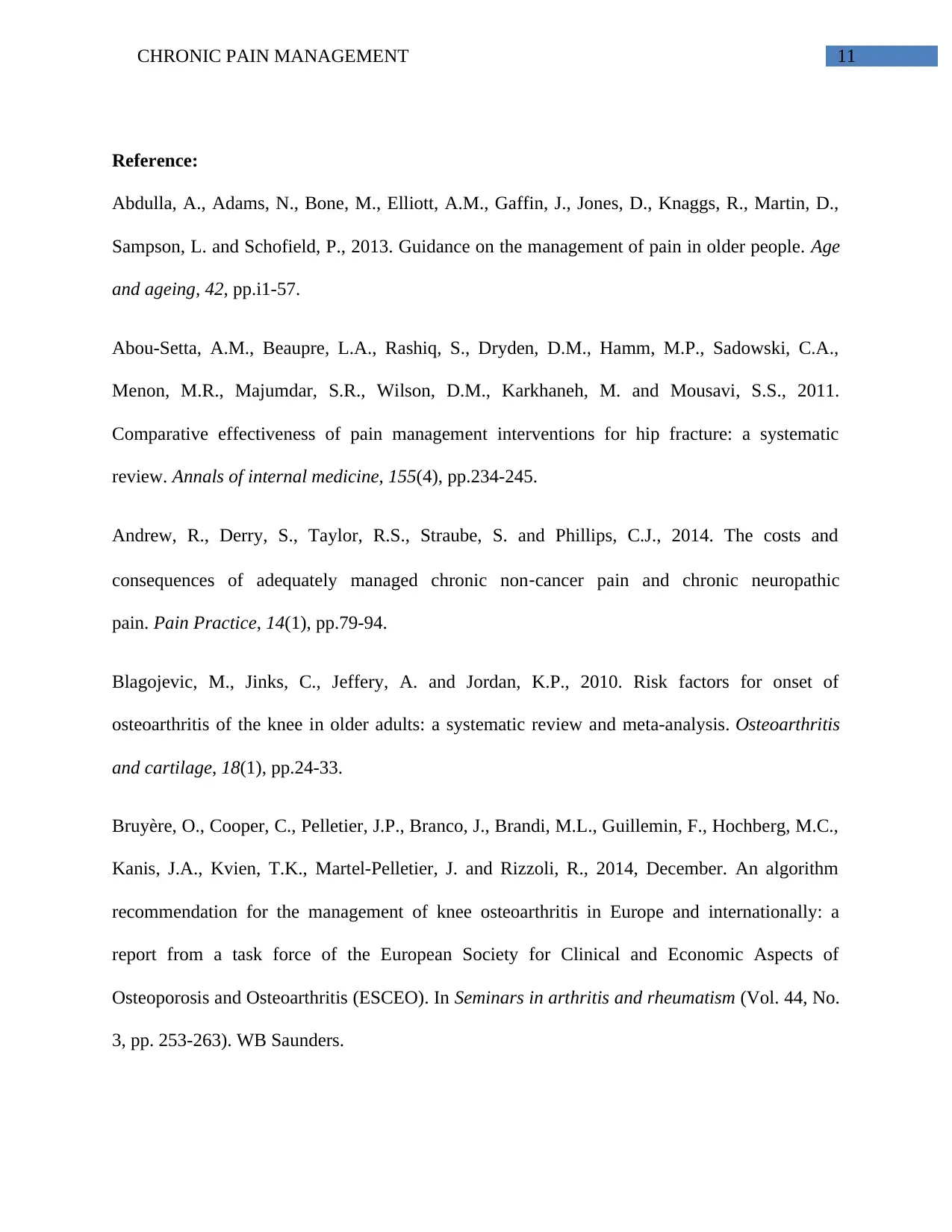
CHRONIC PAIN MANAGEMENT 11
Reference:
Abdulla, A., Adams, N., Bone, M., Elliott, A.M., Gaffin, J., Jones, D., Knaggs, R., Martin, D.,
Sampson, L. and Schofield, P., 2013. Guidance on the management of pain in older people. Age
and ageing, 42, pp.i1-57.
Abou-Setta, A.M., Beaupre, L.A., Rashiq, S., Dryden, D.M., Hamm, M.P., Sadowski, C.A.,
Menon, M.R., Majumdar, S.R., Wilson, D.M., Karkhaneh, M. and Mousavi, S.S., 2011.
Comparative effectiveness of pain management interventions for hip fracture: a systematic
review. Annals of internal medicine, 155(4), pp.234-245.
Andrew, R., Derry, S., Taylor, R.S., Straube, S. and Phillips, C.J., 2014. The costs and
consequences of adequately managed chronic non‐cancer pain and chronic neuropathic
pain. Pain Practice, 14(1), pp.79-94.
Blagojevic, M., Jinks, C., Jeffery, A. and Jordan, K.P., 2010. Risk factors for onset of
osteoarthritis of the knee in older adults: a systematic review and meta-analysis. Osteoarthritis
and cartilage, 18(1), pp.24-33.
Bruyère, O., Cooper, C., Pelletier, J.P., Branco, J., Brandi, M.L., Guillemin, F., Hochberg, M.C.,
Kanis, J.A., Kvien, T.K., Martel-Pelletier, J. and Rizzoli, R., 2014, December. An algorithm
recommendation for the management of knee osteoarthritis in Europe and internationally: a
report from a task force of the European Society for Clinical and Economic Aspects of
Osteoporosis and Osteoarthritis (ESCEO). In Seminars in arthritis and rheumatism (Vol. 44, No.
3, pp. 253-263). WB Saunders.
Reference:
Abdulla, A., Adams, N., Bone, M., Elliott, A.M., Gaffin, J., Jones, D., Knaggs, R., Martin, D.,
Sampson, L. and Schofield, P., 2013. Guidance on the management of pain in older people. Age
and ageing, 42, pp.i1-57.
Abou-Setta, A.M., Beaupre, L.A., Rashiq, S., Dryden, D.M., Hamm, M.P., Sadowski, C.A.,
Menon, M.R., Majumdar, S.R., Wilson, D.M., Karkhaneh, M. and Mousavi, S.S., 2011.
Comparative effectiveness of pain management interventions for hip fracture: a systematic
review. Annals of internal medicine, 155(4), pp.234-245.
Andrew, R., Derry, S., Taylor, R.S., Straube, S. and Phillips, C.J., 2014. The costs and
consequences of adequately managed chronic non‐cancer pain and chronic neuropathic
pain. Pain Practice, 14(1), pp.79-94.
Blagojevic, M., Jinks, C., Jeffery, A. and Jordan, K.P., 2010. Risk factors for onset of
osteoarthritis of the knee in older adults: a systematic review and meta-analysis. Osteoarthritis
and cartilage, 18(1), pp.24-33.
Bruyère, O., Cooper, C., Pelletier, J.P., Branco, J., Brandi, M.L., Guillemin, F., Hochberg, M.C.,
Kanis, J.A., Kvien, T.K., Martel-Pelletier, J. and Rizzoli, R., 2014, December. An algorithm
recommendation for the management of knee osteoarthritis in Europe and internationally: a
report from a task force of the European Society for Clinical and Economic Aspects of
Osteoporosis and Osteoarthritis (ESCEO). In Seminars in arthritis and rheumatism (Vol. 44, No.
3, pp. 253-263). WB Saunders.
⊘ This is a preview!⊘
Do you want full access?
Subscribe today to unlock all pages.

Trusted by 1+ million students worldwide
1 out of 15
Related Documents
Your All-in-One AI-Powered Toolkit for Academic Success.
+13062052269
info@desklib.com
Available 24*7 on WhatsApp / Email
![[object Object]](/_next/static/media/star-bottom.7253800d.svg)
Unlock your academic potential
Copyright © 2020–2025 A2Z Services. All Rights Reserved. Developed and managed by ZUCOL.





